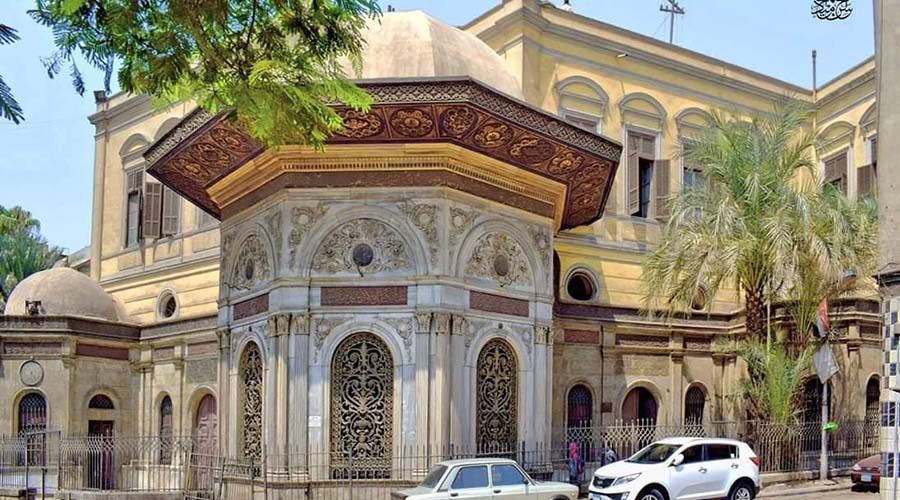Sabil Umm Abbas Cairo Egypt tours, prices, booking, reviews
Sabil Umm Abbas Cairo built by the grand-daughter of Abbas I. Abbas I ruled Egypt from 1848 to 1854. In fact, Sabil Umm Abbas located in quite a remarkable spot off Saliba Street in Cairo. Moreover, it is at the corner of the side alley Al Siufiya. The same alley lies the Palace of Amir Taz. In fact, Sabil is an Arabic word means fountain. It provides the walker in the street with the fresh water. One who builds Sabil, aims to get closer to God according to Islam teachings. Saliba Street reached from Cairo Citadel square. Moreover, it also called Mohammad Ali Square where Sultan Hassan Mosque and Al Rifai Mosque stand. This street recommended for a day walk. It is indeed rich with a flow of interesting monuments. Many of them date back to the Mamluk period.
Sabil Umm Abbas built in 1867. It was upon the order of the Turkish Princess Bambah Qadin, mother of Khedive Abbas II. She known to be a beautiful, kind and distinguished lady. Moreover, she also called Umm al-Mohsenin, which means mother of charity. It was because she gave away so much of her considerable fortune. Sabils were common structures which found in many parts of Islamic Cairo. They date back to Mamluk and Ottoman Periods. In fact, they are small buildings. Moreover, they decorated with elaborate marble facades and bronze window grills. The purpose of the building was of great religious significance during the Islamic periods. It was a way of providing free water for all to drink. In fact, it something regarded in the Quraan.
Further details about Sabil Umm Abbas Cairo:
Quraan is the holy book of Muslims. Quraan refers to the value and importance of water in paradise. Cairo’s first Sabil attributed to Sultan Al Nasir Mohammad. In fact, it built in 1340 as a memorial to his famous father and it’s ruins still remain today. The second Sabil built in Cairo is that of Amir Shaykhoun. It dates back to 1344. Moreover, it located against a rocky cliff on what was once a royal route. It is at the foot of the Mountain Citadel. The purpose of its construction was to quench the thirst of desert travelers. It was also to water people passing between Cairo and the eastern City of the Dead. Another important section of Sabils was a drinking trough for animals.
Sabil buildings were almost a fashion in Cairo. For long periods of time, sultans, princes and rich merchants gifted the city with many of them. They built on busy street corners and whenever possible on the northeast side of a building. It was to provide greatest shade and coolness. It then also became a trend to construct a second story above the Sabil used as a kuttab. Kuttab is a small religious school. It is where the poor could still taught reading and writing Quraan. Umm Abbas spent too much on this little structure. She turned it into an distinguished building. Sabil Umm Abbas Cairo is rounded. It shows much influence of Turkish imperial fountains. It is with its historic inscriptions, bronze window grills and carved wooden hoods.
More details about Sabil Umm Abbas Cairo:
The building facade shows beautiful gilded Ottoman inscriptions. They set above each window grill and circulating around the whole facade. They are on blue and red backgrounds and provide color accents for the white marble faces. The facade also decorated with flowing lines and growing. They are forms of leafy spray and blossomed flowers. Sabil Umm Abbas Cairo held its supply of fresh water in a cool huge stone cistern underground. Once it rises to the surface. Moreover, the water flows out from a small arched marble niche high in the interior wall. It then flows over a beautiful sloping marble slab. It inlay with dazzling mosaic patterns and pours into side water basins. Many had quite a complex and fascinating underground flowing system.
Some Sabils were open only at certain hours. Others remained open day and night. It is except during the fasting hours of Ramadan, when the entire city’s Sabils closed. Sabils all run by a manager or a keeper who makes sure it functions well. He also keeps it clean. Sabil Umm Abbas built as semicircular pavilions. Its decoration was more of an Italian rococo style. The entrance of the building leads to the fountain chamber. It also leads to the staircase of the upper floor. In fact, the building recently restored. Today, the upper floor rooms occupied by a community service organization. The best view of the building is from the western end of the street. In fact, it is the direction of the Citadel.

















